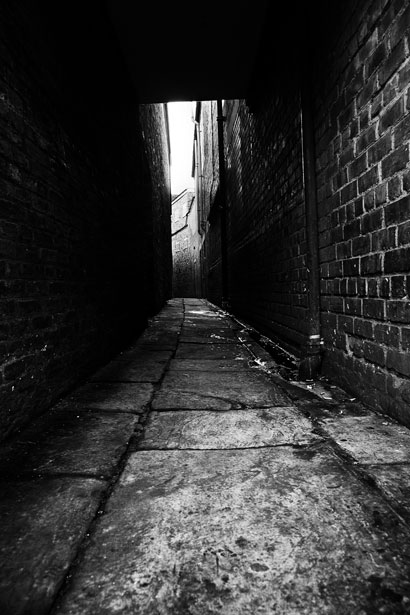 |
LITR 4232 American
Renaissance 2012 final exam—Answers to Question B1 "Gothic characteristics and uses" final exam assignment |
 |
Dorothy Noyes
Spooky Selections: The Gothic in American Renaissance Literature
The scream of the wind through the spindly fingers of the bare-branched
tree. The darkness of the woods in the depths of the night, and the terrifying
possibilities that it encompasses. The aged people and objects, slowly making
their way into the pits of madness and decay. These are images that are par for
the course when reading some of the literature of the American Renaissance. They
are representations of the Gothic images that are portrayed for us, the reader,
in an effort to spook, excite, and chill. The gothic and its implications are
very important to the American Renaissance as it is a tool with which the
authors paint a spine-tingling picture of what scares us the most- both in the
story and within ourselves.
The gothic is a style or genre utilized among authors by the use of
various instruments and images to paint a dark overall picture and make a point
within their work. It is a style that focuses on the dark and scary aspects of
any scene, situation, or character. By emphasizing the darkness, the reader
understands how much they miss the light. In using the gothic, an author can
take something mundane and transform it into something that wreaks havoc on the
mind and soul. There are many different ways of doing this within the gothic,
many forms it can take to get the point across, and all of them are not only
effective, but scary as well.
One aspect of the gothic that is used commonly to illustrate the darkness
and desolation within a piece is the use of colors. The contrast between light
and dark is never as drastic as when they are used in gothic texts. Take the
pictures that are painted of the two women represented in Poe’s “Ligiea.” Ligeia
is the dark and Rowena the light, and they are polar opposites. Ligeia is the
representation of all that is wild and mysterious, her darkness emphasizing
these traits and showcasing the gothic within her character. The same can be
said of Cora in Cooper’s Last of the
Mohicans. Like Ligeia, Cora’s coloring in drastic comparison to Alice’s
fairness indicates a wildness and uncontrollable aspect of her character. These
color-coded gothic signals are incredibly important in allowing a reader to see
the author’s intention, and in seeing their intention, applying the gothic paint
brush that tints the story with its significance.
The personification and application of negative and frightening features
to inanimate objects is also popular in the gothic. Using not only objects
themselves, but the surroundings and settings we can’t avoid in our every-day
lives and applying to them the darkest attributes of the gothic, the readers
can’t help but to feel the desolation and horror associated with them. Houses
especially have played this role in famous gothic works such as Poe’s “The Fall
of the House of Usher” and Irving’s “Rip Van Winkle” take on devastating and
startling personalities. The house in “The Fall of the House of Usher” is
malicious and dangerous to its occupants, driving them to madness while after
twenty long years away, the house of Winkle’s is a rotted shell that clearly
indicates a passage of time Rip Van Winkle does not want to acknowledge. Both
the malice and the decay of the homes of characters force them to examine
terrifying truths that they would have otherwise avoided had they not been their
very surroundings.
Another aspect of the gothic that is featured regularly is that of decay
and ultimate death. These two characteristics are hard to ignore because they
focus on the psychological fears that most individuals harbor of growing old, of
losing what they currently have, and of dying and leaving behind nothing for
which people to remember us. They also illustrate the insignificance of all the
things we as individuals hold dear to us. From the death and loss of all the
female characters in Poe, to the broken, rotted, and smoke-smothered angel
always pointing upwards in “Life of the Iron Mills” the use of death and decay
indicates a terrifying fragility of all existence.
Something I recently noticed and found fascinating in the use of the
Gothic in American Renaissance literature is what seems to be the struggle
between the gothic and transcendence. I saw this most clearly in our final
reading, Rebecca Harding Davis’ “Life in the Iron Mills”. A picture is painted
of these characters that are trying so hard to get out of the hellish existence
that working in the iron mills is. As they try to rise above, those dark
aspects, the filth, danger, flames and cruelty continually pull them back in
despite their longing to transcend and find a safer, more religious, and
peaceful life. The gothic doesn’t just try to scare them in this piece; it is
their reality despite their most valiant efforts. The flames of hell engulf
their reality until, at least in Hugh’s case, the only release and transcendence
is in death. The gothic paired with the gritty realism of the story is
especially powerful.
In closing, the gothic is obviously not only a scary subgenre of
Romanticism used to illicit cheap thrills out of the reader, but something much
deeper and more significant. The gothic is the tool used to examine, understand,
and come to terms with the darkness within every aspect of literature, life and
every individual. It is the representation of a dark dance performed by
everyone, the flirtation with what is forbidden and feared, and the illustration
of the seriousness of the human condition.
